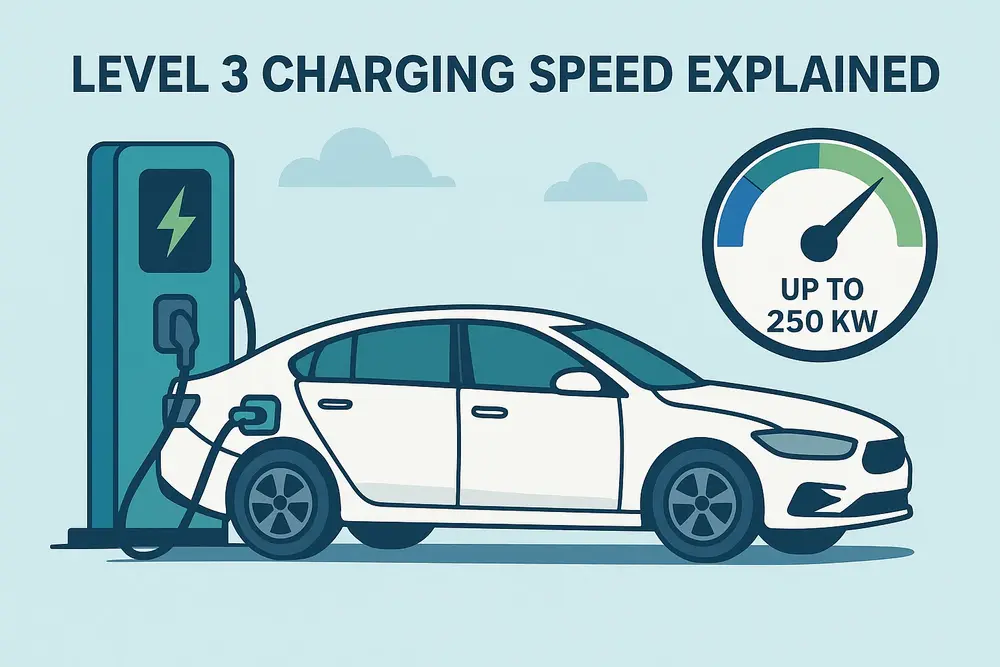Understanding Level 3 EV Charging Speed: What Impacts Fast-Charging Performance?
Level 3 charging, also known as DC fast charging, represents the highest tier of EV charging currently available to the public. Offering extremely fast energy delivery, it enables EV drivers to top up their vehicles significantly quicker than traditional AC methods.

On average, Level 3 charging can recharge a mid-sized EV battery from 20% to 80% in just 17 to 52 minutes. However, real-world charging times can vary significantly due to several key variables. In this article, we break down how Level 3 charging works and explore the factors that influence charging speed.
Contents Overview
- How fast is Level 3 EV charging?
- How does Level 3 charging differ from AC charging?
- Key factors affecting DC fast charging speed
- Fast charging myths and real-world insights
Level 3 Charging Time: At a Glance
Fast-charging speeds vary depending on vehicle type and power output. Here’s a simplified table showing average charging times from 20% to 80% battery capacity:
| Charging Power | Small EV (40kWh) | Medium EV (65kWh) | Large EV (90kWh) |
|---|---|---|---|
| 50 kW | 32 minutes | 52 minutes | 1 hour 12 minutes |
| 100 kW | 16 minutes | 26 minutes | 36 minutes |
| 150 kW | – | 17 minutes | 24 minutes |
| 240 kW | – | 11 minutes | 15 minutes |
| 300 kW | – | 8 minutes | 11 minutes |
⚠️ Actual charging speed depends on the vehicle’s max input, battery condition, and charger capacity.
How EV Charging Works: AC vs. DC
All EVs store energy in DC (Direct Current), while the grid supplies AC (Alternating Current). The difference lies in where the conversion from AC to DC takes place.
- AC charging (Level 1 & 2): Power is converted inside the vehicle using an onboard charger.
- DC charging (Level 3): The charger handles the conversion externally and sends DC power directly to the battery—bypassing slower internal components.
This external conversion allows Level 3 chargers to deliver power outputs of 50 kW up to 400 kW, significantly reducing charging times.
What Affects Level 3 Charging Speed?
1. Charging Station Power Output
Not all Level 3 chargers are created equal. Power ratings can range from 50 kW to over 350 kW. Higher output means faster potential charging, but only if your EV supports it.
2. Vehicle Battery Capacity & Limitations
Every EV has a maximum charging rate. If your EV can only accept 85 kW, using a 300-kW charger won’t make charging faster—it will cap at 85 kW.
Examples:
- Tesla Model 3 Long Range: up to 250 kW
- Fiat 500e: supports up to 85 kW
3. Charger Sharing & Simultaneous Sessions
Most public DC chargers can serve two vehicles simultaneously. However, this means the available power may be split, affecting speed. If possible, use a charger that’s not already in use to maximize charging rate.
4. Battery Temperature
Batteries operate best between 20°C to 25°C (68–77°F). Extreme heat or cold can:
- Reduce charging speed
- Activate thermal management systems
- Divert energy from charging to cooling/heating
5. State of Charge (SoC)
EVs charge fastest between 0% and 80% SoC. The last 20% is much slower to avoid overheating. This is why frequent top-ups to 80% are often more efficient than full charges.
Pro Tips to Maximize Fast Charging Efficiency
- Know your EV’s charging limit: Charging beyond your vehicle’s max input doesn’t help—and may cost more.
- Monitor the SoC: Stop charging around 80% for optimal time efficiency.
- Avoid sharing power: Choose an unused charger if possible.
- Precondition your battery: Some EVs offer pre-heating/cooling options for ideal charging conditions.
Final Thoughts: Is Level 3 Charging Worth It?
For drivers on the move, Level 3 charging is a game changer. Whether you’re planning a long road trip or managing an EV fleet, the ability to recharge in minutes rather than hours can significantly improve convenience and reduce downtime.
While home EV charging with Level 2 remains the most cost-effective daily option, DC fast chargers are essential for:
- Highway stops
- Urban commercial areas
- Ride-share and delivery vehicles
- Emergency top-ups
As EV technology evolves and charging infrastructure expands, understanding fast-charging speeds and limitations will help drivers make informed decisions—and help businesses optimize EV adoption.

